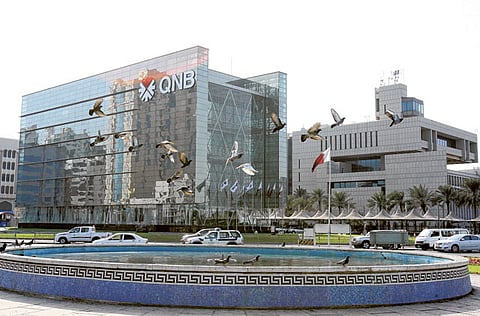Qatari banks defy pandemic's impact on 2020 earnings
Net profit resilient despite higher provisioning charges and pressure on asset yields

Dubai: The combined results of the eight Qatari banks remained strong despite the impact of COVID-19 on operating conditions and rise in provisions, according to rating agency Moody’s.
Aggregate profitability weakened marginally in 2020. The aggregate return on assets was 1.2 per cent, compared with 1.4 per cent in 2019. The banks’ combined net profit declined 12 per cent year-over-year to QAR20.4 billion.
Five of the eight banks reported lower net profit. The decline in bottom-line profitability mainly reflected higher pandemic-related provisioning, which was partly offset by cost savings and higher net interest income.
“We expect bottom-line profitability [of Qatari banks] to remain at the same level in 2021 in the context of slow economic activity, though it will remain relatively strong compared with regional and global peers,” said Nitish Bhojnagarwala, Vice President – Senior Credit Officer at Moody’s Investors Service.
Moody’s expect Qatar’s real GDP to grow by 1.7 per cent in 2021 after contracting by 3.5 per cent in 2020 because of the coronavirus pandemic and decline in oil prices.
According to the rating agency, Qatari banks’ income-generating ability remains strong despite higher provisioning charges related to the pandemic. This reflects the Qatari government’s significant footprint in domestic banks as a shareholder, depositor and customer, which to some extent insulates the banking sector from external events.
Support measures
We expect bottom-line profitability [of Qatari banks] to remain at the same level in 2021 in the context of slow economic activity, though it will remain relatively strong compared with regional and global peers.

A QAR75 billion stimulus and support package to the private sector, equivalent to around 12 per cent of nominal GDP, and a QAR10 billion injection to boost the country’s capital market helped limit the impact of the coronavirus outbreak. Measures introduced in response
to the outbreak included (1) the central bank’s 0% repo facility to support banking sector liquidity; (2) lending initiatives by Qatar Development Bank to help small and medium-sized enterprises (SMEs) with rents and salaries; (3) waivers of electricity and water bills; deferrals of taxes and (4) loan payments and an increase in concessional financing for SMEs.
Interest income and credit growth
The banks’ total income rose 4 per cent to QAR43.9 billion in 2020 from QAR42.1 billion in 2019. The increase was driven by a 9 per cent rise in net interest income that offset an 11 per cent decrease in noninterest income. Operating income grew at all eight banks.
Growth in total income was supported by 7 per cent credit growth year-over-year. Interest income was supported by net interest margins that remained unchanged at 2.1 per cent in 2020 compared with 2019.
Stable net interest margins reflected a decline in asset yields in the current lower interest rate environment, to 4.3 per cent from 5.4 per cent, that was fully offset by a decline in cost of funds to 2.4 per cent from 3.6 per cent.
“Lower interest rates were a large factor contributing to the lower asset yields (the difference between cost of funds and interest income) and cost of funds. Net interest margins could come under pressure in the coming months, though only to a limited extent given our
expectation that liquidity pressure will ease and asset yields will stabilize, said Bhojnagarwala.
Total non-interest income fell to QAR8.5 billion in 2020 from QAR9.6 billion in 2019. The fall reflected a decline in economic activity and a waiver of charges and fees in response to the pandemic that weighed on fees and commission income
Improved efficiency
Moody’s said Qatari banks improved their operating efficiency in 2020 through cost control measures such as reducing staff and travel expenses, which eased the pressure on their bottom-line profit. Operating expenses fell 6 per cent to QAR11.1 billion from QAR11.7 billion a year earlier, while the cost to income ratio fell to 25 per cent from 28 per cent. All eight banks reported a lower cost to income ratio. “We expect this trend to continue as the full impact of cost-control measures in 2020 will become evident by the end of 2021,” said Bhojnagarwala.
Increase in provisions
Moody’s data show Qatari banks’ provisioning increased to QAR10.4 billion in 2020 from QAR6.0 billion in 2019, and consumed around 32 per cent of pre-provision income compared with 20 per cent previously
Most of the increase in provisioning charges in 2020 was because of a rise in expected credit losses in the stage 3 bucket of the banks’ corporate book. However, loan quality had remained relatively stable: the problem loan to gross loans ratio increased marginally to 2 per cent as of December 2020 from 1.9 per cent as of December 2019.
Strong capital buffers
According to Moody’s Qatari banks preserved their capital buffers in 2020, which were stable compared with 2019, supported by lower dividend payout ratios (the dividend payout ratio for 2020 was 40 per cent compared with 45 per cent for 2019) and still strong earnings.
The banks’ combined tangible common equity to risk-weighted assets ratio (TCE ratio) remained stable at 15.1 per cent as at December 2020 compared with December 2019. Of the eight banks, two reported an increase in their TCE ratio in 2020.
Sign up for the Daily Briefing
Get the latest news and updates straight to your inbox







